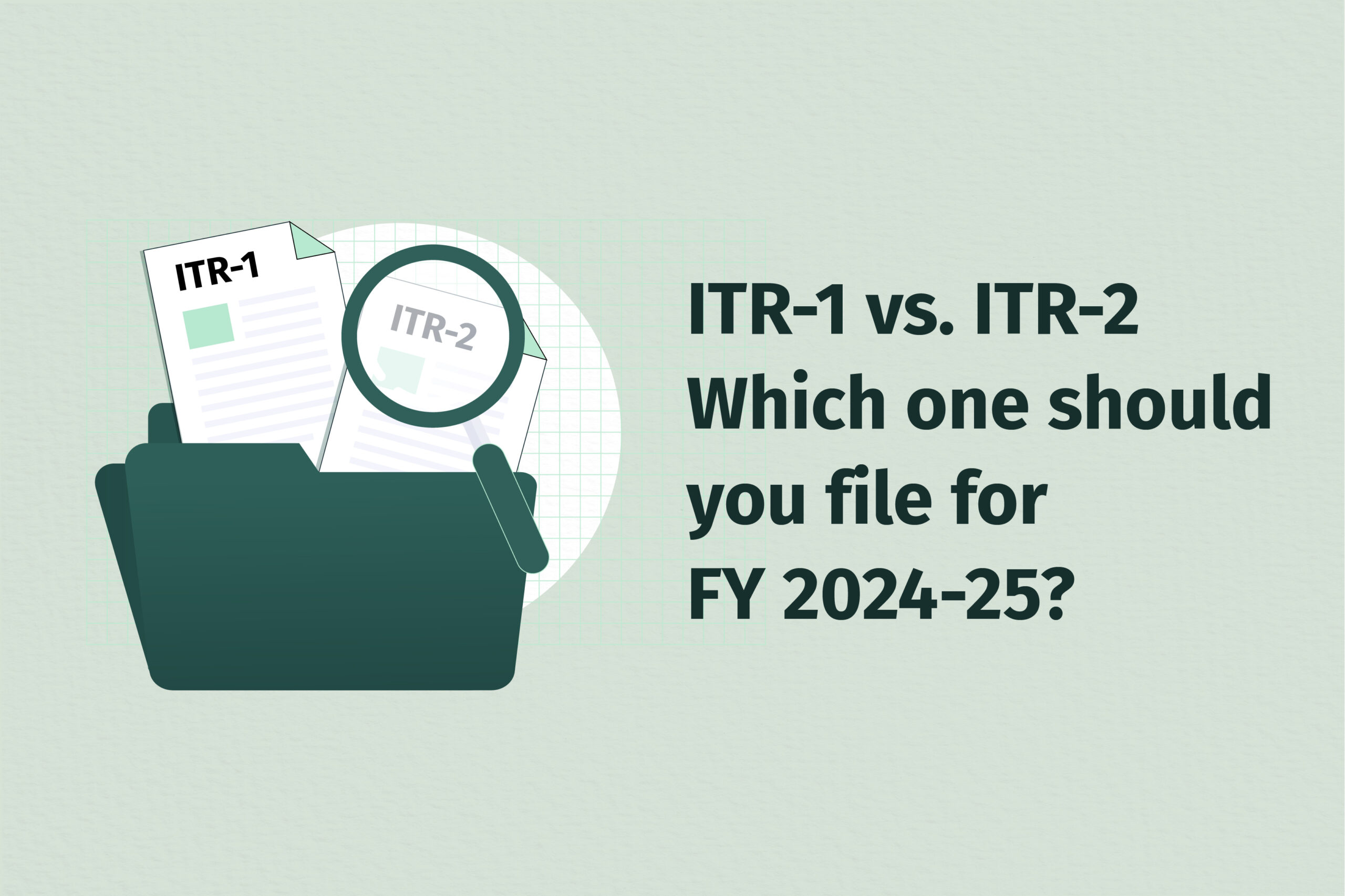Filing your Income Tax Return (ITR) correctly is more than just an annual task, it’s a vital part of ensuring financial compliance and avoiding unnecessary scrutiny from the tax department. For individual taxpayers in India, ITR-1 (Sahaj) and ITR-2 are two of the most commonly used forms. While both cater to individuals without business income, their applicability depends on the nature and complexity of your income. Choosing the wrong form can lead to return rejection, delayed refunds, or even legal consequences.
This blog is a comprehensive comparison of ITR-1 and ITR-2 for the Assessment Year 2025–26, helping you decide which form applies to your income profile. We’ll break down eligibility rules, explore real-life examples, and clarify recent updates from the Budget 2024 and CBDT notifications to help you file with confidence.
Why should you choose the right ITR form?
Selecting the appropriate ITR form is not optional, it’s a legal requirement under the Income Tax Act. If you file your return using the wrong form, your return could be marked as defective under Section 139(9). You may then be asked to revise your return within a given timeframe. Failure to do so could lead to your return being considered invalid, possibly attracting penalties under Section 234F for late filing or even scrutiny from the Income Tax Department.
Moreover, the accuracy of the form used directly affects your refund timeline. Filing with the wrong ITR form might delay the refund process or raise compliance red flags. Therefore, it’s essential to understand your income sources and determine your eligibility before proceeding.
Who should file ITR-1 (Sahaj)?
ITR-1 (Sahaj) is a simplified Income Tax Return form meant for resident individuals with straightforward income sources. It is primarily designed for salaried employees, pensioners, and individuals earning interest from savings or fixed deposits. This form is ideal for those whose total income does not exceed ₹50 lakh and who have income only from salary or pension, one house property, and other sources such as bank interest. Its ease of filing and minimal disclosure requirements make it a popular choice among first-time filers, senior citizens, and individuals with single-source income.
However, ITR-1 is not applicable in certain cases. Individuals who are Non-Resident (NRI) or Resident but Not Ordinarily Resident (RNOR), those with total income exceeding ₹50 lakh, or those having agricultural income above ₹5,000 are not eligible. Likewise, anyone with taxable capital gains (including long-term gains under Section 112A above ₹1.25 lakh), income from gambling or lottery, income from business or profession, or investments in unlisted equity shares cannot file ITR-1.
Who should file ITR-2?
ITR-2 is an Income Tax Return form meant for individuals and Hindu Undivided Families (HUFs) who do not have income from business or profession, but deal with more complex or high-value income sources. Unlike ITR-1, which is limited to basic salary and interest income, ITR-2 caters to those with capital gains, multiple house properties, foreign income or assets, high-income levels, and more. It is commonly used by salaried individuals who invest in equity markets, NRIs with Indian income, or taxpayers who must report specific financial disclosures like unlisted shares or directorship in companies.
Despite being more comprehensive than ITR-1, the ITR-2 form allows for full and accurate disclosure of all income heads (except business income), deductions, exemptions, and foreign holdings.
ITR 1 vs ITR 2: Key differences for FY 2024-25
| Criteria | ITR-1 (Sahaj) | ITR-2 |
| Applicant Type | Resident Individual only | Individuals (Resident, RNOR, NRI) and HUFs |
| Total Income | Allowed only if income is up to ₹50 lakh and no disqualifying conditions apply. | Can be filed regardless of income limit if ITR-1 conditions are not met. |
| Capital Gains Income | Allowed only if LTCG under Section 112A does not exceed ₹1.25 lakh and no capital loss is carried forward | All types of Capital Gains must be reported, including LTCG, STCG, and carry-forward losses |
| Income from Other Sources | Allowed but excludes winnings from lotteries, horse racing, gambling, etc. | Includes all types of income, including winnings from lotteries, races, card games, etc. |
| Agricultural Income | Allowed only up to ₹5,000 | Allowed even if it exceeds ₹5,000 |
| Income from House Property | Allowed for one property only | Can include income from more than one property |
| Foreign Assets / Income | Not allowed | Must be reported if you hold any foreign assets or earn income abroad |
| Unlisted Shares | Cannot be disclosed in this form | Must report holdings in unlisted equity shares |
| Company Directorship | Not applicable | Required to disclose if you are a director in any Indian or foreign company |
| Disclosure of Assets & Liabilities | Not required | Mandatory if total income exceeds ₹1 crore |
| Residential Status | Resident only (excluding RNOR or NRI) | Applies to Resident, RNOR, and NRI |
Real-life examples: Which ITR form fits?
To understand the difference more practically, here are some relatable examples:
1) ITR-1 for pensioner with interest income
Gaurav is a retired government employee. In FY 2024–25, he receives a pension amounting to ₹35 lakh and also earns ₹2.5 lakh in interest from fixed deposits with a nationalised bank. He does not have any capital gains, foreign income or assets, nor any business income or multiple house properties. His total income is well below the ₹50 lakh threshold, and he does not fall under any complex reporting categories such as directorship or unlisted shares.
Given the simplicity of his income sources, limited to pension and bank interest, Gaurav qualifies to file ITR-1, which is specifically designed for individuals with income from salary or pension, one house property, and other sources (like interest), provided the total income does not exceed ₹50 lakh.
2) ITR-2 for equity mutual fund investor –
Muskan is a salaried professional who also invests in equity mutual funds. During the financial year, she sold some of her mutual fund units, resulting in capital gains of ₹2.3 lakh. Along with this, she earned dividend income from the same investments. She has no business income, does not own multiple properties, and her total income is below ₹50 lakh.
However, the presence of capital gains, even if the amount is relatively modest, makes her ineligible for ITR-1. Since ITR-1 does not support capital gains reporting, Muskan is required to file ITR-2, which includes the necessary schedules for declaring gains from mutual funds, dividend income, and other relevant disclosures related to investment income.
ITR-1 vs ITR-2 for salaried employees
For most salaried employees with a straightforward salary, a single house property, and income from interest or tax-saving instruments (like PPF or FDs), ITR-1 is sufficient. However, if the salaried individual receives stock options like RSUs or ESOPs from their employer, especially a foreign employer, or has capital gains from sale of shares, mutual funds, or crypto assets, then ITR-2 becomes mandatory. This is because ITR-1 does not support reporting of capital gains or foreign assets.
For example, Gaurang, a software engineer in India holding RSUs from a US-based company must report the value of those RSUs (if vested/sold) and any foreign income. In such cases, ITR-2 ensures proper disclosure of stock-based compensation, foreign holdings, and investment-related tax details.
ITR-1 vs ITR-2 for NRIs
Non-Resident Indians (NRIs) and Residents but Not Ordinarily Resident (RNOR) are not eligible to file ITR-1, regardless of income level. This restriction arises due to residential status and the possibility of foreign income, assets abroad, or remittances, all of which require detailed disclosure.
For instance, if an NRI earns rental income in India or capital gains from selling Indian property, or holds a foreign bank account, they are required to file ITR-2. Moreover, where Double Taxation Avoidance Agreement (DTAA) benefits are claimed (e.g., for interest or dividend income taxed both abroad and in India), such claims can only be reported using ITR-2, which accommodates such international tax considerations.
Foreign assets & income: Automatic disqualification from ITR-1
The moment you hold any foreign asset, be it an overseas bank account, ESOPs from a foreign employer, foreign mutual funds, or cryptocurrency traded on international platforms, you are instantly disqualified from using ITR-1. Even if your income is under ₹50 lakh, ITR-1 does not support foreign income disclosures, which are mandatory under the Black Money Act and related reporting obligations.
ITR-2, on the other hand, provides detailed sections to report foreign bank accounts, overseas employment income, foreign pension, and investments, ensuring you comply with FBAR-equivalent reporting and Indian tax regulations.
Owning more than one house? ITR-2 is a must
If you own more than one residential property, regardless of whether it is rented, self-occupied, or vacant, you cannot use ITR-1. This is because ITR-1 permits only one house property in your return. So, if you have a second flat for investment, family use, or rented out for passive income, you will need to report the second property as either deemed let-out or actual let-out, depending on usage. Only ITR-2 accommodates this level of disclosure, including details on rental income, municipal taxes, standard deduction, and housing loan interest.
Agricultural income above ₹5,000? Why ITR-2 is mandatory for you
Section 10(1) of the Income Tax Act exempts agricultural income from taxation. However, when agricultural income exceeds ₹5,000, you cannot file ITR-1, even if the rest of your income is simple. This is because ITR-1 has restrictions on reporting exempt incomes beyond this threshold.
Say you own farmland and earn ₹25,000 as income from growing crops, this income, while exempt, affects tax computation and must be included in the return via proper disclosure in ITR-2, which has dedicated fields for exempt agricultural income and supports composite tax treatment when applicable.
What happens if you file the wrong ITR form?
Filing the wrong Income Tax Return (ITR) form can lead to several consequences. The Income Tax Department may flag your return as defective under Section 139(9), especially if the form used does not match your income profile, for instance, using ITR-1 despite having capital gains or foreign assets. In such cases, you will be notified to correct and refile your return within a specified time. If not rectified, your return is treated as invalid, meaning it’s as if you never filed it. Thankfully, if you realise the mistake yourself, you can submit a revised return using the correct form before the due date or before the assessment is completed.
ITR 1 vs ITR 2: Budget 2024 updates
The Union Budget 2024-25 introduced some subtle but important changes affecting ITR selection. One of the key updates was increased scrutiny for high-income individuals and stricter reporting requirements for foreign income and assets. The CBDT also clarified that taxpayers with even minor capital gains or holding unlisted shares must file ITR-2, not ITR-1. Additionally, changes to TDS rates and thresholds may reflect differently across forms. It’s important to refer to the latest ITR schema notified by the CBDT each year to ensure you pick the right form aligned with new compliance mandates.








